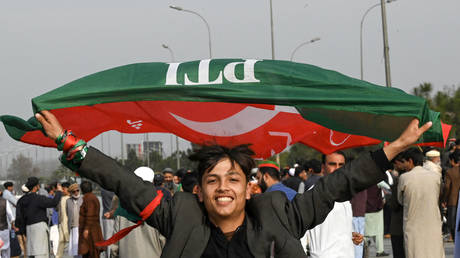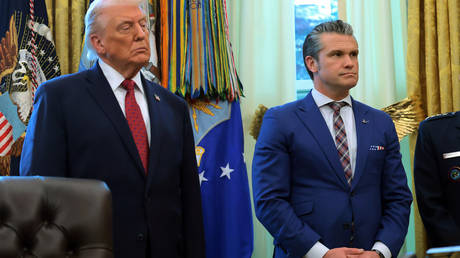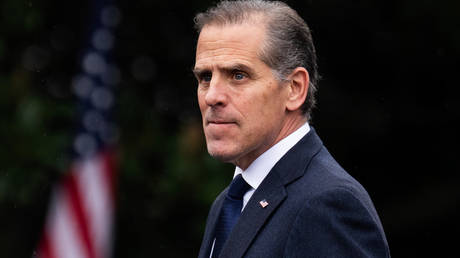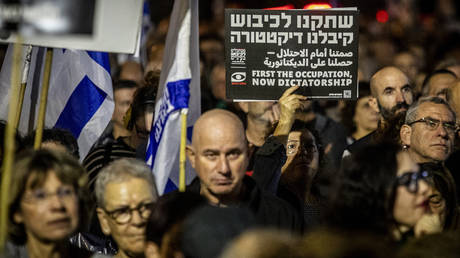
National polls held last week resulted in no party securing a clear majority. However, forming a government is not the key challenge
Independent candidates linked to the Tehreek-e-Insaf (PTI) party led by former cricketer and prime minister of Pakistan Imran Khan – who was jailed weeks before the elections, on charges which he claims are politically motivated – have won the most seats in parliament. It’s a somewhat unexpected development for a South Asian nation where the military has historically served as and remains the primary arbiter of politics.
The electoral commission on Sunday announced that numerous independent candidates aligned with PTI had secured seats in the National Assembly during the February 8 vote, propelling the party into a leading position with 97 out of 265 seats. Five other independent candidates, not affiliated with Imran Khan, also secured seats.
The PTI’s closest contender was the Pakistan Muslim League (PMLN), led by Khan’s longstanding adversary, former Prime Minister Nawaz Sharif, with 76 seats. The Pakistan People’s Party (PPP) won 54 seats and several smaller parties also clinched seats, resulting in key parties having to carry out intricate negotiations to form a government. Given the absence of a clear majority for any party and the widespread allegations of vote manipulation from various quarters, Pakistan’s political and economic future hangs in the balance.
Following the February 8 general election, domestic media have been reflecting on the significance of their outcome for the nation’s political landscape. The success of independent candidates backed by the Tehreek-e Insaf party has led journalists and analysts to speculate on how exactly the establishment will react to the will of the people and whether this might bring about a transformation of the existing political system. These debates are all the more intriguing if we consider the general mood in the country ahead of the election.
Jailed Favourite
As early as August 2023 (in fact, even before that), it became apparent that the leaders of the Pakistan Democratic Movement (PDM) coalition government were not planning to give up power easily and give it to supporters of Imran Khan, arguably the most popular politician in the country. Khan was ousted as prime minister after losing a vote of no confidence in April 2022 that, he then alleged, had been plotted by a US-led foreign conspiracy that also involved Pakistan’s powerful military.
It was the leadership of the Pakistan Muslim League (N) (PML-N) that was particularly reluctant to share power with Imran Khan’s party and was waiting for PML-N’s leader, Nawaz Sharif, to return from London and launch his campaign to become prime minister for the fourth time. Imran Khan’s sharp-tongued supporters labeled all initiatives coming from the PML-N as the ‘London Plan’, believing, justifiably, that these were developed in coordination with the military elite.
In any case, politicians needed more time to implement whatever plans they had in mind. The early dissolution of the National Assembly (the lower house of Pakistan’s parliament) in early August meant that the election would be held in 90 days rather than 60. But even that was not enough: the sudden call for a new census and a redrawing of the country’s electoral borders pushed the election to an even later date.
As a result, the vote was postponed to February, so Nawaz Sharif had the time to make a grand return to Pakistan’s politics in October and ‘sort out the legal issues’ – the man was facing a number of corruption charges that barred him from participating in the poll. In a lucky twist, the Supreme Court decided to remove these obstacles. Everything seemed to be going according to plan.
But the plan apparently had a flip side. After the May riots over the attempted arrest of Imran Khan, Pakistan’s civil-military leadership finally had their hands free and unleashed the full force of the administrative apparatus on Pakistan Tehreek-e Insaf. The rioters were branded ‘terrorists’, which reflected poorly on the party as a whole and made its members reconsider whether to continue their political careers within the PTI.
Several party leaders, concerned about the prospect of being summoned to testify before a military tribunal, left the party to establish new political movements. These movements echoed the PTI’s overall policy agenda while steering clear of confrontation with the establishment. Party officials who remained loyal to Imran Khan faced assaults, arrests, searches, and other problems. Khan himself received a total sentence of over 30 years across various cases.
Against this backdrop, no one expected the election to produce any surprises. A clear favorite seemed to have emerged, and the main rival party was defeated: the independent candidates supported by the PTI now had no party symbols to run under, which made them far less visible on the ballot. But here is where the situation went off script.
Waiting for Midnight’s Children
Election day was marred by several terrorist attacks, clashes between supporters of different parties, and accusations of fraud. By evening, however, it was all over, and the nation waited for midnight to hear the results. As the hour approached, however, no information was forthcoming, and Imran Khan’s supporters started releasing unofficial reports that independent candidates had won in 134, 150, or 170 of the 264 constituencies designated by the Election Commission of Pakistan (ECP).
It was not until the early hours that the first official numbers came in. The PTI’s supporters did indeed perform well, overtaking all registered parties, including the PML-N. Although the victory of the independent candidates was not as overwhelming as they had claimed, the results of their rivals were even more modest. The PML-N and the Pakistan’s People’s Party (PPP) won just over 70 and 50 seats, respectively, while the independent candidates garnered more than 90 seats.
The composition of the future government has not yet been determined, but the major systemic parties (led by the PML-N and PPP) are in talks to form a coalition government along the lines of the PDM. This is clearly not what the PML-N candidates expected. However, Nawaz Sharif is likely to succeed in forming a government. And then, the election results will be the smallest of his problems.
The first of the looming problems is a political one. Now, as of February 2024, the roles look obvious: the establishment has a clear favorite (the blue-eyed) and the archenemy. However, the situation was just the opposite only two years ago, when Imran Khan claimed “being on one page” with the military on all crucial issues and the top army brass turned a blind eye to prosecution of the opposition (the future PDM government), “because the Army stays outside of political processes”. Practice has proved, however, that pages can be turned.
Navaz Sharif has a long and complex history of relationships with the establishment. He was brought down three times: in 1993, through the efforts of President Ghulam Ishak Khan, in 1999 after Gen. Pervez Musharraf’s military coup, and in 2017, amid charges of corruption. Widely considered power-hungry and headstrong, his desire to restrain the power of top army generals has cost him his position as the Prime Minister. There is no assurance that Sharif doesn’t disappoint his protectors or make serious mistakes in key areas – especially with so many sensitive matters out there for him to stumble upon.
No Man Ever Steps in The Same River Twice
Modern Pakistan’s biggest pains lie in the field of economy. High inflation (29%), a budget deficit of 9.1% of GDP, and an external debt of 36.5% of GDP are the most critical of them. Blaming Imran Khan government’s “incompetent management” suited Sharif’s electoral campaign perfectly, but the question remains – how is he going to correct that?
His campaign office came up with the simplest recipe – touting the economic successes of the past. Indeed, under Sharif’s rule the China-Pakistan Economic Corridor (CPEC) kicked off, along with many other infrastructure projects, and GDP boasted growth rates of 4 to 6 percent.
A lot has changed since then, though: the CPEC got bogged down due to financing and security problems, which had begun before Imran Khan came to power in 2018. Pakistan itself lack financial resources to boost its economic development, so the government’s first task will be another round of talks with the IMF about a new aid package.
The IMF’s terms are known in advance: the country needs difficult structural reforms, the effect of which will only be felt after a long time. The reforms will affect taxation and budget expenditure on critical economy sectors, energy being the first of them. The population is hardly going to be happy about them, but something must be done, as the time to tout one’s past achievements is long gone. Besides, the international situation has also changed significantly.
Old New Frenemies
The main foreign policy vectors will remain unchanged. The prospects of China-Pakistan relations don’t raise any questions — the all-weather partnership is sure to remain an imperative for Pakistan’s foreign policy. However, there is no certainty that the Pakistani track generates as much interest in Beijing. Nonetheless, the political, trade, investment and military cooperation between Pakistan and China require that any administration in Islamabad pursue a predictable and consistent policy towards Beijing.
The Indian track is more susceptible to surprises. On one hand, India-Pakistan relations almost entirely froze after India revoked the special status of Jammu and Kashmir in 2019. Islamabad is unwilling to concede due to ideological reasons, while New-Delhi pointedly shows no interest in this issue, considering it resolved once and for all.
On the other hand, it was Sharif who secured a thawing of relations with New-Delhi first in 1999 and then in 2015, negotiating visits by India’s prime ministers to Pakistan. However, the positive effects he managed to achieve did not last long and ultimately led to yet another military showdown between the two nations. Today, the parties are so irreconcilable on the key issue of their bilateral agenda that even a short-term thaw seems highly unlikely.
Regarding Afghanistan and the Frontier, another historically problem-plagued track, the fate of this region is hardly controlled by the civil government. The situation in the provinces of Khyber Pakhtunkhwa and Balochistan, scarred by active terrorist activities of the Tehrik-e Taliban Pakistan (TTP) that opposes federal government intervention in the lives of Pashtuns and insists on reformatting Pakistani statehood in the manner of Taliban-ruled Afghanistan, can only be addressed by the armed forces.
Military success in remedying the situation depends on the strategy they choose towards the militants and local residents dissatisfied with the federal government’s policies. The civil and military leadership share a common objective though – to continue dialogue with the Afghan Taliban in an attempt to reach a compromise on the Afghanistan-Pakistan border and negotiate conditions for international recognition of the Kabul regime.
The relations between Islamabad and Moscow, which has been closely observing Pakistan’s Afghan policies and promoting dialogue on a broad range of security issues, are likely to remain unchanged. The positive dynamic of Russia-Pakistan interactions observed since 2014 has slowed following Imran Khan’s visit to Moscow on February 23-24, 2022, and the launch of Russia’s military operation in Ukraine. There has been no visible setback, but no positive prospects have emerged, either.
Apparently, the situation is further aggravated by the new government’s task of restoring relations with the West. However, the example set by many countries in the Global South, particularly India, has proven that it is possible to have partnerships with both Russia and the West, which can be beneficial for all parties involved.




